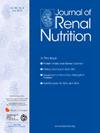低血浆海洋 N-3 多不饱和脂肪酸与维持性血液透析患者心血管事件风险增加有关。
IF 3.2
3区 医学
Q2 NUTRITION & DIETETICS
引用次数: 0
摘要
目的:探讨血液透析(HD)患者血浆n-3多不饱和脂肪酸(n-3 PUFAs)、二十碳五烯酸(EPA)和二十二碳六烯酸(DHA)与心血管(CV)事件和全因死亡率的关系。方法:前瞻性多中心队列研究,随访5年。主要结局是心血管事件,次要结局是全因死亡率和心血管事件的各个组成部分。血浆EPA和DHA的总和以海洋n-3 PUFAs的重量百分比(wt%)表示。根据血浆n-3 PUFA水平将种群分为三类:低三类为6.52 wt%。结果:共纳入336例患者。中位随访时间为5.05(5.02-5.07)年。一般来说,较低的分值与较高的心血管事件风险相关。未经调整,中位数与心血管事件风险降低36%相关[HR 0.64 (95% CI 0.43-0.96)],中位数与心血管事件风险降低34%相关[HR 0.66 (95% CI 0.44-0.98)]。在调整混杂因素后,中位数与较低的心血管事件风险[HR 0.60 (95% CI 0.40-0.92)]、外周动脉疾病(PAD) [HR 0.44 (95% CI 0.22-0.88)]和全因死亡率[HR 0.61 (95% CI 0.42-0.86)]相关。限制三次样条显示,低于中位数5.7%的患者的CV风险更高,表明存在潜在的阈值效应。结论:低血浆海洋n-3 PUFA水平与HD患者心血管事件、PAD和全因死亡率升高相关。本文章由计算机程序翻译,如有差异,请以英文原文为准。
Low Plasma Marine N-3 Polyunsaturated Fatty Acids are Associated With Increased Risk of Cardiovascular Events in Patients Treated With Maintenance Hemodialysis
Objective
This study investigated the association between the plasma marine n-3 polyunsaturated fatty acids (n-3 PUFAs) eicosapentaenoic acid and docosahexaenoic acid and cardiovascular (CV) events and all-cause mortality in patients treated with hemodialysis.
Methods
Prospective multicenter cohort study with 5 years of follow-up. Primary outcome was CV events and secondary outcomes were all-cause mortality and each component of CV events. The sum of plasma eicosapentaenoic acid and docosahexaenoic acid was expressed as marine n-3 PUFAs in weight percentage (wt%). The population was divided into tertiles according to plasma n-3 PUFA levels: lower tertile <5.06 wt%, middle tertile 5.06-6.52 wt%, and upper tertile >6.52 wt%.
Results
In total, 336 patients were included. Median follow-up was 5.05 (5.02-5.07) years. Generally, the lower tertile was associated with a higher risk of CV events. Unadjusted, the middle tertile was associated with a 36% lower risk of CV events [hazard ratio (HR) 0.64 (95% confidence interval (CI) 0.43-0.96)], and the upper tertile was associated with a 34% lower risk of CV events [HR 0.66 (95% CI 0.44-0.98)]. After adjusting for confounders, the middle tertile was associated with a lower risk of CV events [HR 0.60 (95% CI 0.40-0.92)], peripheral arterial disease [HR 0.44 (95% CI 0.22-0.88)], and all-cause mortality [HR 0.61 (95% CI 0.42-0.86)]. A restricted cubic spline showed that the CV risk was higher in patients with levels below the median of 5.7 wt%, indicating a potential threshold effect.
Conclusion
Low plasma marine n-3 PUFA levels were associated with a higher risk of CV events, peripheral arterial disease, and all-cause mortality in patients treated with hemodialysis.
求助全文
通过发布文献求助,成功后即可免费获取论文全文。
去求助
来源期刊

Journal of Renal Nutrition
医学-泌尿学与肾脏学
CiteScore
5.70
自引率
12.50%
发文量
146
审稿时长
6.7 weeks
期刊介绍:
The Journal of Renal Nutrition is devoted exclusively to renal nutrition science and renal dietetics. Its content is appropriate for nutritionists, physicians and researchers working in nephrology. Each issue contains a state-of-the-art review, original research, articles on the clinical management and education of patients, a current literature review, and nutritional analysis of food products that have clinical relevance.
 求助内容:
求助内容: 应助结果提醒方式:
应助结果提醒方式:


